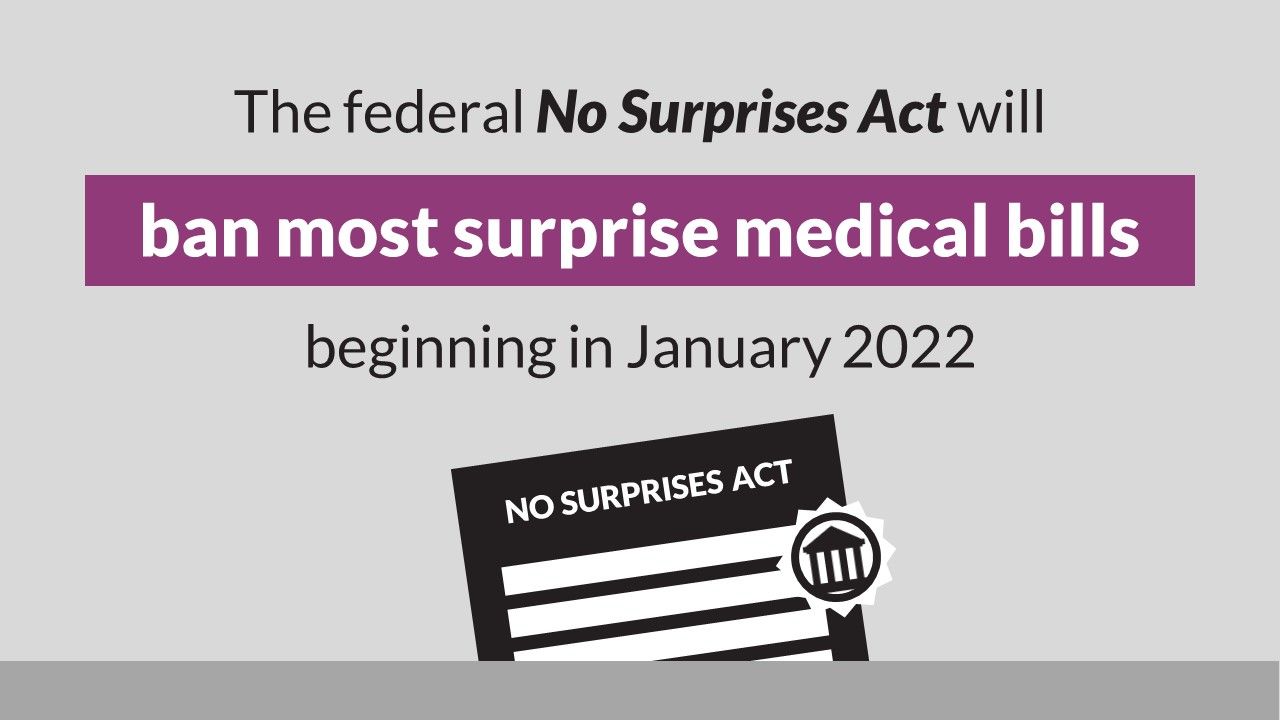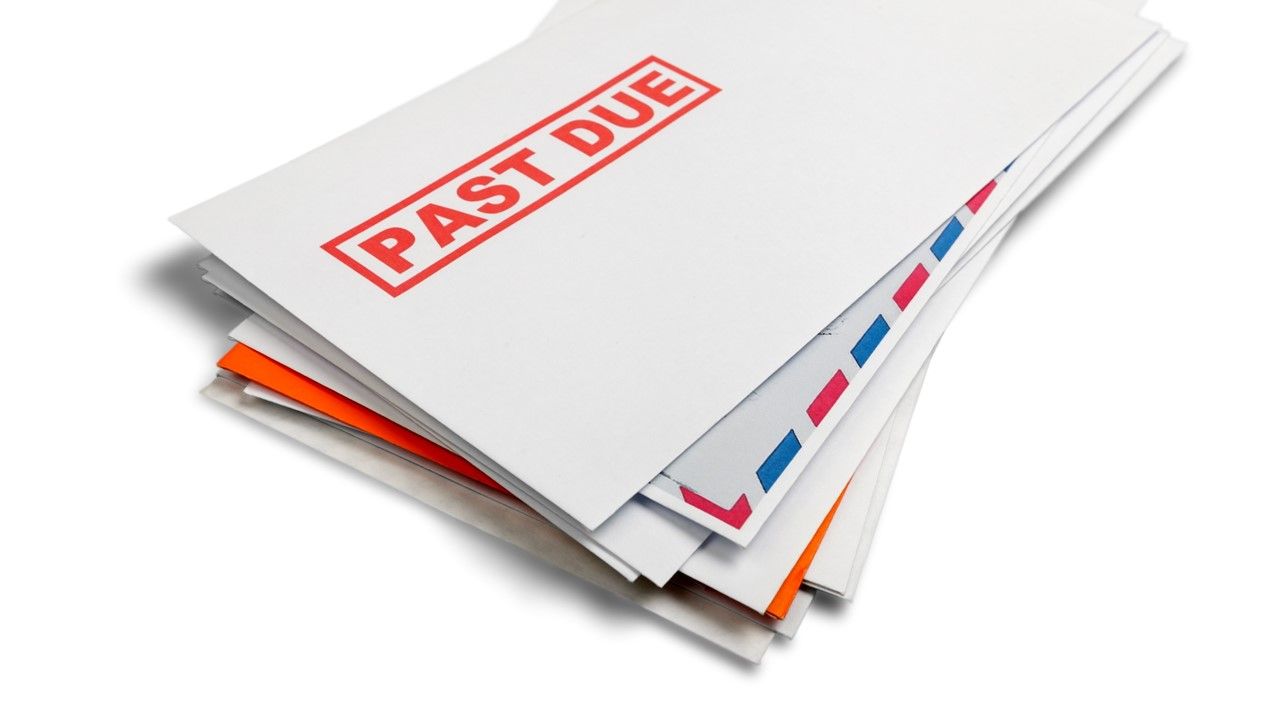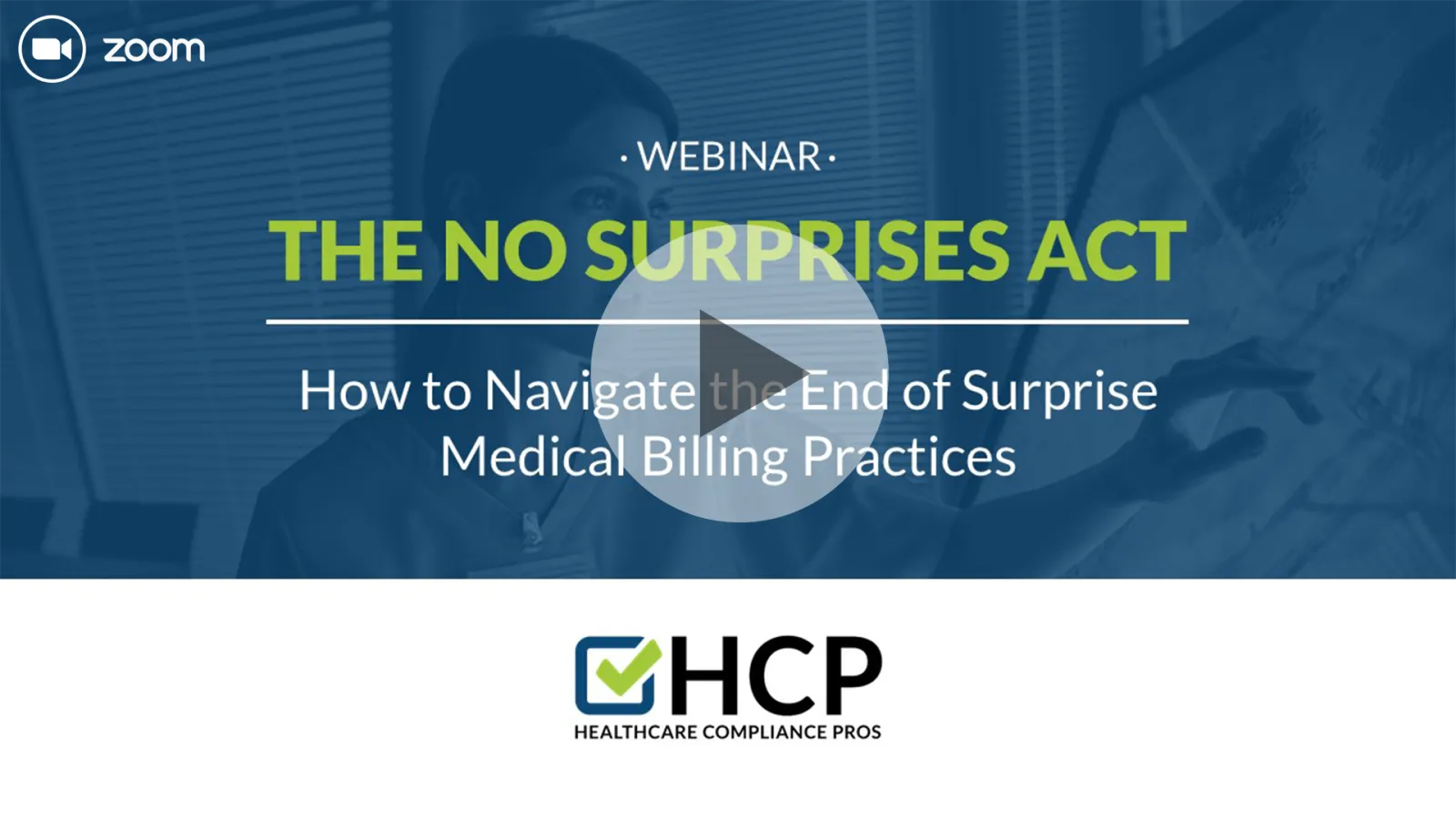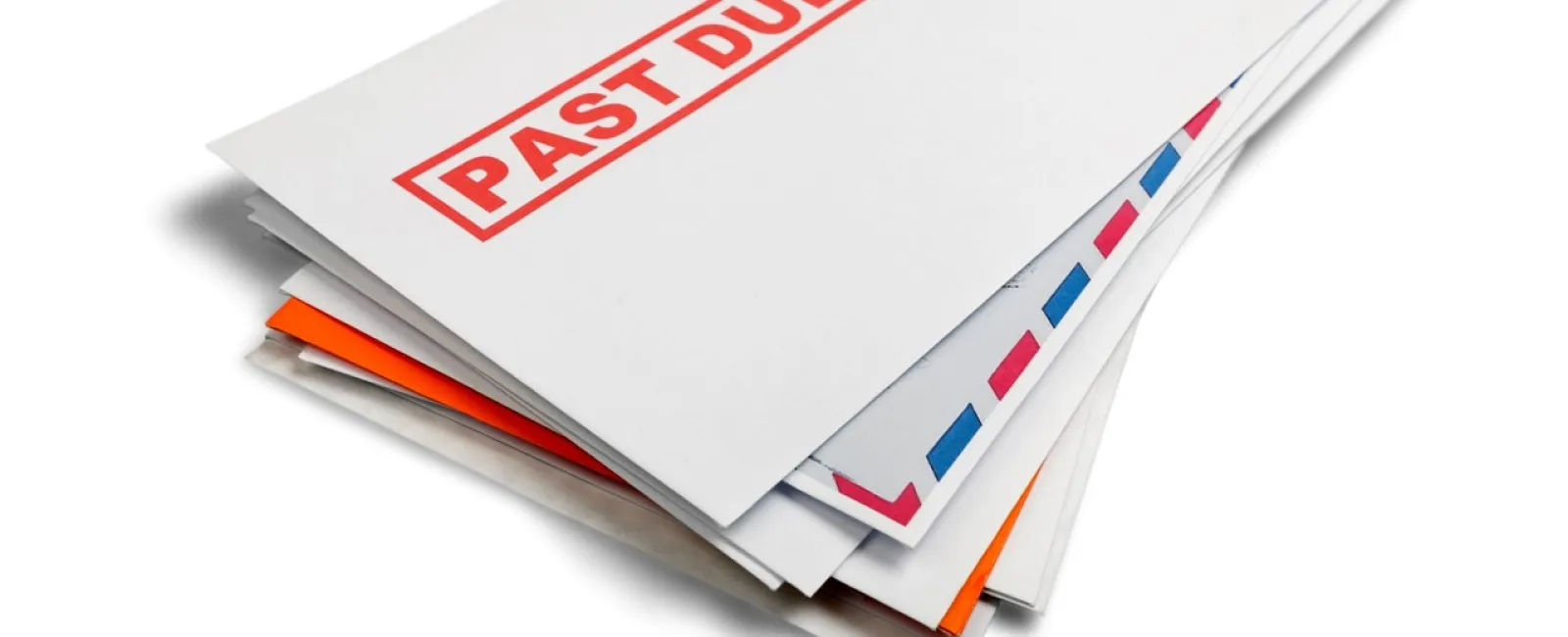The No Surprises Act 2022: What Your Organization Needs to Know
JUMP TO THE SECTION
Does the surprise medical bills act have you confused? Does it make as much sense as a three-dollar bill? You are not alone, so HCP is here to help. Recently, the American Medical Association (AMA) and the American Hospital Association (AHA) filed lawsuits against the No Surprises Act, stating the final rule ignores certain elements that lawmakers initially approved. This publication will focus on what providers need to know about the No Surprises Act in 2022 before the requirements become enforced.
High-Level Background on the No Surprises Act
The No Surprises Act was signed into law as part of the Consolidated Appropriations Act of 2021 on December 27, 2020, and contains the provisions that make up the No Surprises Act. The Department of Health and Human Services (HHS), Department of Labor (DOL), the Department of Treasury, and the Office of Personnel Management issued an interim final rule on July 1, 2021. This interim final rule contained several provisions of the No Surprises Act.
HHS, DOL, the Department of Treasury and Personnel Management issued a second Interim Final Rule on September 30, 2021, implementing additional parts of the No Surprises Act. The requirements of the No Surprises Act for Providers, Facilities, and Providers of Air Ambulance Services that apply go into effect on January 1, 2022. After a one-year grace period, the standards will become enforceable by 2023 and subject to HHS investigation at the department's discretion.
Overview of Purpose & Requirements

According to the Centers for Medicare & Medicaid Services (CMS), provisions that apply to providers, facilities, and providers of air ambulance services, include cost-sharing rules, prohibitions on balance billing for certain items and services, notice and consent requirements, and requirements related to disclosures about balance billing protections. Of the requirements, there appears to be the most confusion regarding providing a good faith estimate, notice and consent requirements, and patient-provider dispute resolution.
It's important to note these requirements generally apply to items and services provided to individuals enrolled in group health plans, Federal Employees Health Benefits plans, or individual health insurance coverage. The good faith estimate requirement and the other requirements related to the patient-provider dispute resolution process also apply to the uninsured. Furthermore, CMS declares these requirements do not apply to beneficiaries or enrollees in federal programs such as Medicare, Medicaid, Indian Health Services, Veterans Affairs Health Care, or TRICARE because these programs have other protections against high medical bills.
Good Faith Estimate
Providing good faith estimates for uninsured or self-pay patients is one of the most difficult requirements for providers and facilities. Perhaps this is why HHS is exercising enforcement discretion between January 1, 2022, through December 31, 2022, since establishing a process and learning how to provide good faith estimates to uninsured or self-pay individuals will require some time to figure out.
According to CMS, when scheduling an item or service, or if requested by an individual, providers and facilities are required to inquire about the individual's health insurance status or whether an individual is seeking to have a claim submitted to their health insurance coverage for the care they are seeking.
Starting January 1, 2022, providers and facilities must provide a good faith estimate of expected charges for items and services to an uninsured (or self-pay) individual, meaning an individual who:
- Does not have benefits for an item or service under a group health plan, group or individual health insurance coverage offered by a health insurance issuer, federal health care program, or a health benefits plan; or
- Has benefits for such items/services under a group health plan, group or individual health insurance coverage offered by a health insurance issuer, or a health benefits plan, but does not seek to have a claim submitted to their plan, issuer, or carrier for the item or service.
The good faith estimate must include expected charges for the items or services that are reasonably expected to be provided together with the primary item or service, including items or services that may be provided by other providers and facilities.
CMS has provided the following example for a surgery good faith estimate. It might include the cost of the surgery, any labs or tests, and the anesthesia that might be used during the operation. If an item or service is something that isn't scheduled separately from the surgery itself, it will generally be included in the good faith estimate. Other items or services related to the surgery that might be scheduled separately, like pre-surgery appointments or physical therapy in the weeks after the surgery, won't be included in the good faith estimate.
For more detailed information on "Good Faith Estimates Compliance," view the educational compliance webinar available on-demand (designed by our team of compliance advisors):
📽️ Watch Again: Replay the Good Faith Estimates Compliance Webinar Recording (04/05/2022), if you would prefer an audio learning style; or
📄 Check out PDF copy: Download your copy of all of the Webinar Slides (PDF), especially if you learn better from a printable version.
Notice & Consent
Information regarding the availability of a "Good Faith Estimate" must be prominently displayed on the convening provider's website, the convening facility's website, and in the office or on-site where scheduling or questions about the cost of healthcare occur.
Once HHS developed a model notice, our compliance team uploaded it for clients to access online within our Forms Section. Using the HHS model notice as a template ensures the requirements of the No Surprises Act are met. The notice must include the following elements:
- A plain-language summary of the consumer protections afforded by the No Surprises Act.
- A plain-language summary of any applicable state balance billing law(s).
- Appropriate contact information for state and federal agencies the individual may contact if the individual believes the facility or provider has violated a requirement specified in the notice.
Fair warning, this process appears to be more than a once-and-done requirement. Based on our review it appears the notice is required to be provided in person or through mail or email (patient preference) for each new patient encounter (other than follow up visits) no later than the date on which the provider or facility requests payment from the individual, or if payment is not requested from the patient, the date when a claim is submitted to the plan or issuer.
Patient-Provider Dispute Resolution

According to CMS, starting in January 2022, if an uninsured (or self-pay) patient is billed for an amount that exceeds the good faith estimate they were provided, the patient can use a new patient and provider dispute resolution process to determine a payment amount. Consumers will be eligible to use this process if they have a good-faith estimate, a bill within the last 120 calendar days, and the difference between the good-faith estimate and the bill is at least $400. The patient must initiate the process within the 120-day window from the time they received the bill, file the required documentation, and pay a $25.00 administrative fee.
As part of this process, consumers will also be able to request a third-party arbitrator to review the good faith estimate, their bill, and information submitted by their provider or facility to determine if the additional charges are allowed or if the provider or facility can only charge the amount on the good faith estimate.
Disputes Between Providers, Facilities, & Health Plans
There still appear to be questions regarding disputes between providers, facilities, and health plans, which led to legal challenges from AMA, AHA, and other provider organizations.
According to CMS, to protect consumers from surprise medical bills, starting in 2022 consumers with health insurance generally won't be responsible for balance bills or out-of-network cost-sharing when getting emergency care, or non-emergency care from out-of-network providers at in-network facilities, and air ambulance services from out-of-network providers. When this happens, instead of the consumer paying for out-of-network costs and balance billed amounts, they'll generally only need to pay their normal in-network costs. The provider and the consumer's health plan can negotiate the total payment amount to the provider. Historically, this has not always been a straightforward process and can be very time-consuming.
The No Surprises Act includes a process for resolving payment disputes between a provider or facility and a health plan. When a provider or facility and a health plan can't agree on the payment amount for an out-of-network service experienced by a patient, they'll be able to initiate a new federal independent dispute resolution process.
Starting January 1, 2022, after receiving a payment from a health plan or a notice of denial, either the health plan, the provider, or the facility can choose to start an open negotiation period that lasts 30 business days. If the health plan and provider or facility can't agree on a negotiated rate, either can begin the independent dispute resolution process.
This is the specific part the lawsuit filed by AMA, AHA, and other healthcare organizations take exception to. Currently, the independent dispute resolution process:
- Brings in a third party known as an independent dispute resolution entity to decide the payment amount. The parties may mutually select the certified independent dispute resolution entity, and everyone involved must attest to having no conflicts of interest.
- Requires the provider or facility and the health plan to each submit a payment offer to the certified independent dispute resolution entity and any additional information supporting their payment offer. The certified independent dispute resolution entity will consider any evidence submitted for a patient whose in-network cost-sharing is more or less than the value of the item or service provided.
- Requires the certified independent dispute resolution entity to select from the payment offers. Both the provider or facility and the health plan must commit to whatever the independent dispute resolution payment is, and payment must be made within 30 business days.
According to the lawsuit, the new rule places a heavy thumb on the scale of an independent dispute resolution process, unfairly benefiting commercial health insurance companies. We will be keeping an eye on the lawsuit to see what, if anything, changes.
You Have Access To HCP Resources For Help
Healthcare Compliance Pros has created the following resources for our clients:
- Good Faith Estimate Form
- Surprise Billing Model Notice
- Right to Good Faith Estimate Notice
- Training based on the CMS No Surprises Act presentation slides
- Additional No Surprises Act resources will be available soon.
These compliance resources are ready and accessible to our clients via the HCP portal. Login with your credentials to add these No Surprises Act resources to your compliance program or contact your dedicated support team to ask compliance questions.
Not an HCP client yet?
The quickest way to access the No Surprises Act resources is by scheduling a free online consultation. There, you will learn about the all-in-one platform designed by compliance specialists to help you manage your compliance program (HIPAA, OSHA, Corporate Compliance, Human Resources, Coding Billing, and more). Access policies, implement procedures, receive unlimited compliance support from specialists, and gain up to $1 million of assurance package to protect against an external audit.
For more detailed information on "The No Surprises Act Compliance" you can access today, view the educational compliance webinar available on-demand (powered by our team of compliance advisors):
📽️ Watch On-Demand:
Replay the No Surprises Act Webinar Recording (02/08/2022) for auditory learners; or
📄 Download the PDF:
Review all of the No Surprises Act Webinar Slides (PDF), especially if you learn better from
a printable copy.

The No Surprises Act Webinar Recording (02/08/2022)

